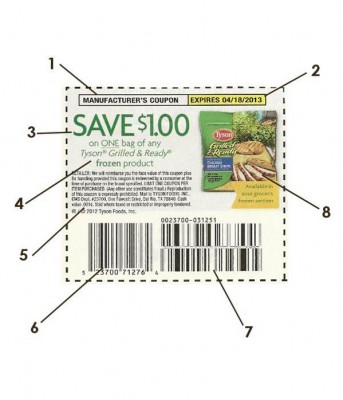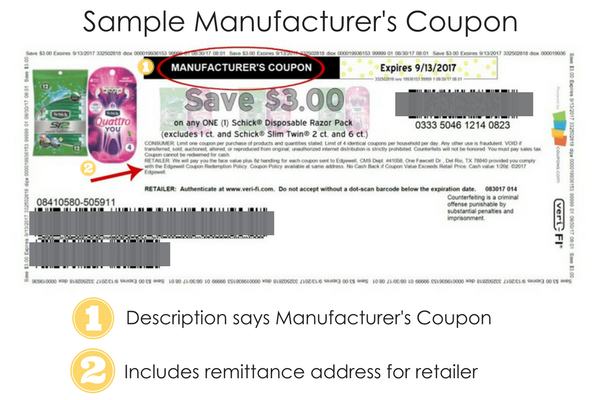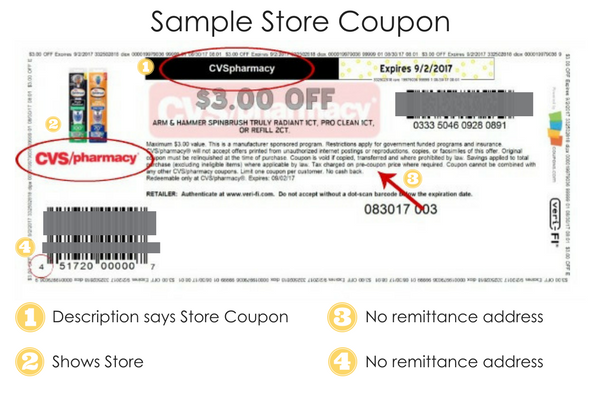
Coupons are a simple way to save money on the items you need. But, there is more to it than just printing or clipping the coupon and taking it with you to the store. You need to understand how to read your coupons, so you use it in the right way.
Make sure you check out our How to Use Coupons page for the help you need to start learning to save more money!
PARTS OF THE COUPON
Here is a breakdown of the various parts of the coupon and what each one means to you:
1 – Defines it is a Manufacturer’s Coupon which means you can redeem it anywhere coupons are accepted
2 – Expiration Date is the date through which the coupon can be redeemed
3 – Total Amount You Will Save when redeeming this single coupon
4 – Product Description / Quantity Required to Use the Coupon
5 – Redemption Address and Coupon Limitations
6 – Barcode to match up to product which ensures you are purchasing the correct product(s)
7 – Barcode which is to be scanned by the cashier to apply the discount
8 – Image of at least one product, which may not necessarily be the only item you can buy with the coupon
Let’s dig into these coupons a bit more to explain each of these sections and how it affects the way you can use your coupons.
COUPON QUANTITY REQUIREMENTS
Each coupon is clear about the number of items you must to redeem it. There are different ways they do this. These examples will help explain it.
Example 1: $1.00/1 or $1.00 off the purchase of one item
In this case, you can save $1.00 when you buy just one item. The coupon will deduct once for each barcode scanned, so you can use one coupon per product. Therefore, when you purchase 2 items, use 2 coupons – one on each product.
Example 2: $1.00/2 or $1.00 off the purchase of 2 items
This means you will need to buy two items in order to use the coupon. Your total savings will $1.00 total – or $0.50 off of each. For example, if something costs $2.50, you will purchase 2 for $5 before you hand over the coupon. Once the coupon is scanned, your purchase price will be $4 or $2 per item. If you want to use two coupons, you need to purchase 4 items.
Example 3: Buy one Product A, get another Product A free
This coupon requires the purchase of two items. One will be free and the other will be at regular (or sale) price. You are limited to one coupon per purchase – which means per item. Since the purchase requires 2 items to be purchased, you can only redeem one coupon on that product.
REDEEMABLE AT vs. AVAILABLE AT
Sometimes, coupons include additional wording that states available at or redeemable at. At first glance, it appears you can only the coupon use at the store listed. However, that may not always be the case.
REDEEMABLE AT “STORE”
If your coupon has this wording, you can use it anywhere coupons are accepted (within the store’s coupon policy, of course). The manufacturer was paid to include the store’s logo on the coupon to get more people to shop there.
While this is an ad, some stores refuse to accept any coupon with any other store logo on it, regardless of the wording.
REDEEMABLE ONLY AT “STORE”
If the coupon has this wording, then you can only use the coupon at this store. The only exception is if your store accepts competitor coupons of this type.
AVAILABLE AT
This wording means the same as Redeemable At. It is simply an advertisement to let you know that this store carries the product. You are not obligated to use it only at that store.
So, what do you do if your store refuses to accept the coupon? First and foremost, do not get angry with the cashier. He/she is only doing the job as trained. There could be confusion and/or a lack of understanding as to the wording. Immediately ask to see the store manager and talk with him or her about it. If they still refuse, you can leave the store or just elect not to use the coupon.
MANUFACTURER vs. STORE COUPONS
There are times when coupons are store coupons rather than manufacturer coupons. If it is a store coupon, it means you can only redeem it at the store that issued it. But, how can you tell the difference between the two?
Description
The simplest way to know is to look for wording on the coupon. If it says manufacturer’s coupon, then you know it is and should be able to be redeemed anywhere.
The confusion lies in if a store name is listed.
There are times when it may appear to be a store coupon when it is not. That means you have to look further.
Redemption Address
Look for a redemption address. Store coupons do not need to send the coupon anywhere for reimbursement, so there will not be a remit to the address listed. However, manufacturer’s coupons must have this data listed so that the store can get their money back. Without that data, they can’t submit it.
Barcode
Store coupons usually have a “4” at the front of the barcode. This indicates that it is a store coupon rather than a manufacturer’s coupon.
PICTURES
When manufacturers place images on the coupon, they often put an expensive product. In addition, they may also put a photo of a product that is a larger quantity than must be purchased.
Never use the photo when determining which product to buy. Use the wording instead. Always.
EXPIRATION DATE
All coupons will have an expiration date on them. This is most often at the very top of the coupon, so that it is easy for you to identify.
Coupons can be used until midnight on the date they expire. That means, you can use it at 11:57 p.m. on the expiration date and can still be accepted.
Also see: Coupon fine print – Everything you need to know!
THE ONE PER RULE
Coupons all limit the number of coupons you can use on a purchase or within a transaction. In the case of coupons, purchase means product. The terms are interchangeable.
One per purchase
This wording is where product and purchase are used in the same way. That means once the coupon has been applied to your products, it can’t be applied to any others. Let me show a couple of examples to you to explain this in more detail:
- If the coupon requires a purchase of one item to be redeemed, you can buy 2 items and use 2 coupons. The coupon limits one coupon for each item purchased.
- If the coupon requires a purchase of two items to be used, you would need to buy 2 items and use one coupon. The coupon requires two products to be purchased to be used. Those two items means a purchase. Since the coupon limits on coupon per purchase, you can’t use another coupon on those same two items. In this case, if you want to use two coupons, you would need to purchase 4 items.
One per transaction
Your transaction is your shopping trip. It is everything you are buying at that time. If the coupon has limits as to the number of coupons you can use in a transaction, then you can’t use more than that.
One example may be a limit of 4 coupons in a transaction. If you buy 4 items, you can use 4 coupons. However, if you buy 5 products, you can still use only 4 coupons.
One per customer
You are the customer and so you can only use one coupon when you shop – no matter how many items you buy. If you want to use multiple coupons, you will have to leave the store and return and make another purchase.
However, if you have family members with you, they are also customers. You can hand them the product and coupons and they can run their own transaction, allowing you to redeem the coupon.
One per visit
This is the most uncommon type of restriction on a coupon. A visit is when you are at the store. If you have 2 coupons you want to use, you would need to make a purchase and leave. Then, return later and use the second one.
Keep in mind that some stores may even constitute what makes a visit. We had one locally that said 2 hours = 1 visit. That meant you could not return prior to that 2-hour window in order to qualify for another visit.


